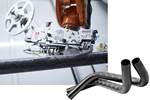Alformet launches online thermoplastic composite tube designer
Professional design engineers to composite enthusiasts now have access to a web shop platform for creating and ordering standard or fully customized composite tubular products with ease.
Thermoplastic composites producer Alformet GmbH (Dörth, Germany) announces the launch of its new web shop, providing engineers, academics and hobbyists access to custom-designed tubular thermoplastic composite products. The online platform, now live at www.alformet.com, enables users to design, configure and purchase high-quality composite tubes tailored to their specific needs.
Alformet’s online tool is made to simplify the design process for tubular thermoplastic composites by offering a user-friendly interface that guides customers from concept to completion. This is a small but important step in Alformet’s vision of commoditizing thermoplastic composite products,
“We’re excited to offer this new level of accessibility to our customers,” says Lucas Ciccarelli, managing director for Alformet GmbH. “Our goal with this platform is to streamline the process of creating high-performance composite tubes, from the initial design all the way to final production. It’s never been easier to turn an idea into a tangible product.” The web shop’s debut was featured in a webinar hosted by Composites United, where the functionality and ease of use were demonstrated to a wide audience.
Related Content
-
Plant tour: Albany Engineered Composites, Rochester, N.H., U.S.
Efficient, high-quality, well-controlled composites manufacturing at volume is the mantra for this 3D weaving specialist.
-
PEEK vs. PEKK vs. PAEK and continuous compression molding
Suppliers of thermoplastics and carbon fiber chime in regarding PEEK vs. PEKK, and now PAEK, as well as in-situ consolidation — the supply chain for thermoplastic tape composites continues to evolve.
-
Recycling end-of-life composite parts: New methods, markets
From infrastructure solutions to consumer products, Polish recycler Anmet and Netherlands-based researchers are developing new methods for repurposing wind turbine blades and other composite parts.














